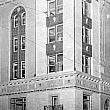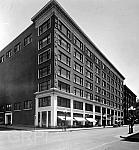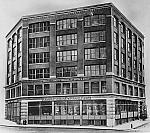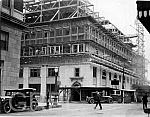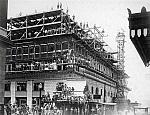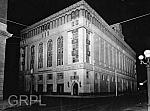Going to Market
by Charles Gerena
Marketing has always been a challenge for furniture producers. In the 1870s, several Grand Rapids companies chartered railroad cars to carry their products from town to town for buyers to examine. A salesman or executive from the company would entertain customers and take orders as the car stood on a rail siding. Earlier, Boston manufacturers took their products to neighboring towns by boat, holding auctions at dockside. Furniture manufacturers in New York and other parts of the Northeast began using warehouses to cooperatively market their products during the 1880s. Still, “buyers had to go from one small display to another at great expense and inconvenience.”
The first market in 1874 was held in Boston since many producers were located in New England. Later, Swedish furniture makers that clustered around Jamestown in western New York and Dutch furniture makers near Grand Rapids held their own markets. Several exposition buildings went up in Chicago between 1896 and 1924 to reflect that city’s emergence in the furniture industry. North Carolina manufacturers also attended the furniture markets in New York, Grand Rapids, and Chicago. Though they had mass-produced furniture since the 1880s, it would take several decades for them to form a market of their own.
The Great Depression interrupted the furniture industry’s growth. In High Point, attendance at the Southern Furniture Market fell in the early 1930s as manufacturers went bankrupt or consolidated. The market recovered with the economy in the latter part of the decade. More buyers stopped in High Point on their way to or from the larger markets in Chicago, New York, and Grand Rapids. Not only did Southern manufacturers give them more of what they wanted — North Carolina and Virginia accounted for about one-third of all bedroom and dining room furniture made in the United States by 1937 — but it was easier to get to High Point due to enhancements in rail and road transportation.
Interest waned in other furniture markets. Grand Rapids held its last market in 1965, while Chicago and New York markets lost their “big show” status. Articles published by the High Point Enterprise in October 1960 captured the changing preferences of buyers. “Chicago has become no more than a courtesy call for our buyers,” noted an executive from a small department store chain in Milwaukee. “I don’t go to Chicago anymore. Everything I need is in the South,” said another buyer from Massachusetts.
Once High Point gave retailers what they wanted, its furniture market expanded in scope and eventually stole the international spotlight from Grand Rapids, Mich., and other centers of furniture marketing in the Northeast and Midwest.
Excerpted from Region Focus, Summer 2007

 facebook
facebook